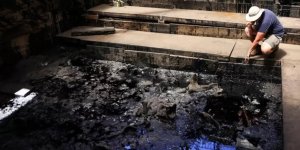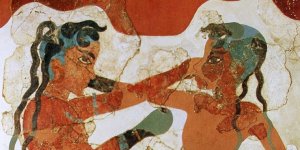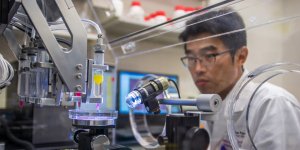Science News

Researchers documented the largest known single dinosaur track in Alaska. »

Radiocarbon dating on bones in the La Brea Tar Pits warns that history may be repeating. »

Scientists with the Agricultural Research Service (ARS) have shown that seed meal from plants in the mustard family can kill mosquito larvae, which start their lives in stagnant water before emerging into winged adults that take to the air in search of a blood meal. »

The discarded peels of aloe vera can be used as a natural pesticide, helping farmers protect staple food crops from harmful insects. »

Scientists from the Federal University of Santa Maria (UFSM) have discovered a fossil in São João do Polêsine, Rio Grande do Sul state, belonging to a precursor of the pterosaurs, an extinct clade of flying reptiles. »

Octopuses use RNA editing to rapidly respond to environmental temperature changes by altering protein function. »

An experiment on coral reefs provides the first evidence that predators use other animals for motion camouflage to approach their prey without detection. »

Tapping seismic data, research shows solid metal sphere is planet within a planet. »

Finding contradicts previous assumptions about the role of mobile plate tectonics in the development of life on Earth. »

Scientists have pinpointed a genetic cause for virgin birth for the first time, and once switched on the ability is passed down through generations of females. »

The product can be used to remove drug residues, according to research. »

Fast data transmission could be delivered in homes and offices through light emitting diode (LED) bulbs, complementing existing communication technologies and networks. »

Scientists have made a breakthrough in understanding and overcoming the challenges associated with nickel-rich materials used in lithium-ion batteries. »

Advance presages a new era of prosthetics wrapped in self-healing synthetic materials. »

The researchers found that targeted deep brain stimulation during a critical time in the sleep cycle improved memory consolidation. »

Rare earths are critical components in almost all modern technologies, from smartphones to hard drives. »

A scented rice variety grown in India’s remote northeast, known as Joha rice, not only prevents type 2 diabetes but is also rich in unsaturated fatty acids, which work against heart disease. »

A new study has uncovered how the interplay between Sargassum spp., plastic marine debris and Vibrio bacteria creates the perfect "pathogen" storm, with implications for marine life and public health. »

Honey bees are more faithful to their flower patches than bumble bees when it comes to returning to collect more pollen and nectar, according to a study by U.S. Department of Agriculture Agricultural Research Service scientists. »

Some 100 million years ago, trendsetting moths started flying during the day rather than at night. »

The link between ancient volcanic eruptions and the most severe extinction event the world has ever seen just got even stronger. »

Oak Ridge National Laboratory scientists found that a small tweak created big performance improvements in a type of solid-state battery, a technology considered vital to broader electric vehicle adoption. »

Brain wave patterns show elephant seals take short naps while holding their breath on deep dives. »

Results may lead to engineering multifunctional structures and materials that change properties on demand. »

Parts of the human genome that have remained unchanged for millions of years shed light on diseases and unusual traits. »

Findings point to brain areas in the motor cortex that integrate planning, purpose, physiology, behavior, movement. »

Scientists with the Agricultural Research Service are building a better mouse trap when it comes to cat litter. And in the process, they hope to kill two birds with one stone. »

Scientists working at the Department of Energy’s Oak Ridge National Laboratory have produced a signature nuclear reaction that occurs on the surface of a neutron star gobbling mass from a companion star. »

Researchers are working to create artificial fluids that mimic many of the properties of natural proteins. »

Anthropologists have long thought that our ape ancestors evolved an upright torso to pick fruit in forests, but new research by scientists at the University of Michigan suggests a life in open woodlands and a diet that included leaves drove apes' upright stature. »

Scientists working to determine what will happen to massive carbon stores as rainforests dry out. »

Dark Energy Camera captures the glowing remains of the first documented supernova. »

Research conducted via global-scale seismic imaging of Earth’s interior. »

A 2017 comet's unusual acceleration explained by hydrogen outgassing from ice. »

Nonfood, plant-based biofuels have potential as a green alternative to fossil fuels, but the enzymes required for production are too inefficient and costly to produce. »

Sorghum bran, often a low-cost byproduct of sorghum milling, can enhance gluten-free bread's nutritional value without compromising its flavor, according to a study. »

Researchers find less expensive, more efficient material design for water purification. »

Many tropical forests are experiencing increases in lightning and lianas, thanks in part to global change. »

Microfossils help monitor when deep-sea methane deposits convert to gas and rise to the seafloor. »

Scientists have traced the family trees of two transmissible cancers that affect Tasmanian devils and have pinpointed mutations which may drive growth of deadly diseases. »

Inspired by one of the mysteries of human perception, an ORNL researcher invented a new way to hide sensitive electric grid information from cyberattack: Within a constantly-changing color palette. »

Overuse of antibiotics in agriculture can lead to the emergence of bacteria resistant to the body’s innate immunity, a study led by the University of Oxford suggests. »

A new image reveals the most detailed map of dark matter distributed across a quarter of the entire sky, reaching deep into the cosmos. »

Researchers found some of the lowest rates of heart and brain disease ever reported. »

For the first time, astronomers have observed, in the same image, the shadow of the black hole at the centre of the galaxy Messier 87 (M87) and the powerful jet expelled from it. »

Researchers at the U.S. Department of Agriculture's Agricultural Research Service recently developed sustainable machine-washable antimicrobial wipes that can be used at least 30 times for cleaning hard and nonporous surfaces. »

Alternative way to produce colored paint that is more environmentally friendly. »

Study analyzes avian cross-country biodiversity changes over a year. »

Ice sheets can retreat up to 600 metres a day during periods of climate warming, 20 times faster than the highest rate of retreat previously measured. »

Scientists believe that Earth’s core is a massive ball of iron. However, a new discovery suggests that the Earth’s core is surrounded by an unexpected ancient structure. »


